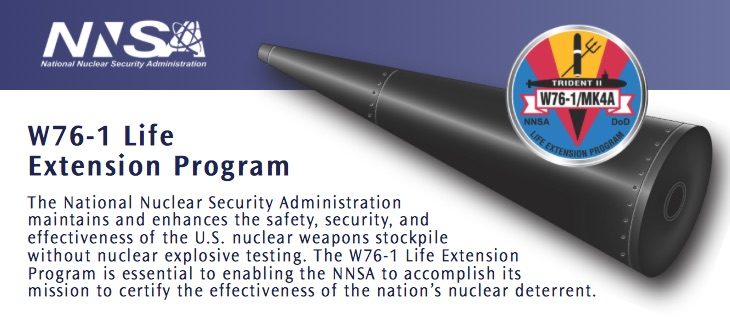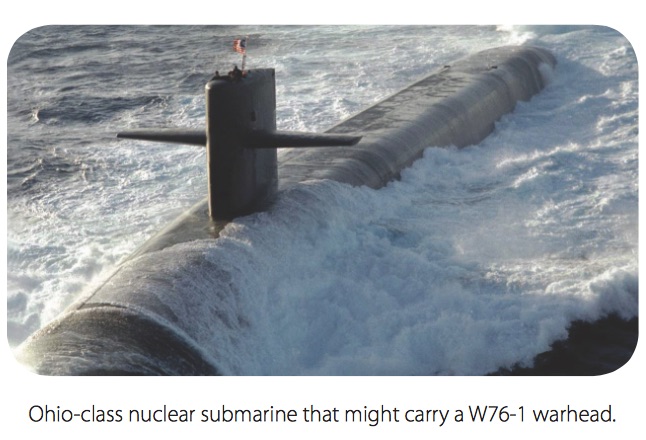Note This story was updated at 4:40 p.m. Jan. 26.
After two decades, work was completed in December on a program to extend the life of the W76 nuclear warhead, the Y-12 National Security Complex said on Monday.
That ended a decade of work to extend the service life of the original warhead design by 40 years, Y-12 said.
“This warhead plays a vital role in maintaining the nation’s credible nuclear deterrent,” said Consolidated Nuclear Security LLC, which manages and operates Y-12 for the National Nuclear Security Administration.
The Life Extension Program, or LEP, is for the W76-1 warhead. The W76-1 is a refurbished W76-0 warhead. The W76-0 warhead is a submarine-launched ballistic missile system that was first introduced into the stockpile for the U.S. Navy in 1978. The warhead is deployed with Trident II D5 missiles on Ohio-class nuclear ballistic missile submarines.
“W76 warheads comprise a large share of the U.S. nuclear stockpile,” according to the U.S. Government Accountability Office.
NNSA completed the first W76-1 production unit in September 2008, and the first delivery of warheads to the Navy took place in fiscal year 2009, according to a program fact sheet.
“The W76-1 warhead will play a critical role in allowing the United States to maintain a credible nuclear deterrent during stockpile reduction over the next several decades,” the NNSA said.
The NNSA, which is part of the U.S. Department of Energy, had announced more than four years ago, in October 2014, that it had reached the halfway point in the production phase of the W76-1 Life Extension Program. By November 2016, the program had completed more than three-quarters of the total number of refurbished warheads scheduled for delivery to the Navy and was on track to complete production in 2019.
“The W76-1 Life Extension Program is fully consistent with the U.S. commitment to not develop new nuclear warheads,” the NNSA said. “It continues to meet all missions and capabilities of the original W76-0 warhead and does not provide new military capabilities.”
The W76-1 Life Extension Program has involved engineers, scientists, and technicians from Y-12 in Oak Ridge; Pantex Plant near Amarillo, Texas; Savannah River Site near Aiken, South Carolina; Kansas City National Security Campus in Missouri; Los Alamos National Laboratory in New Mexico; and Sandia National Laboratories in Albuquerque, New Mexico. Los Alamos National Laboratory and Sandia National Laboratories designed the original W76-0 warhead, and they have been the design agencies for the refurbished W76-1 warhead.
DOE and the NNSA celebrated the completion of the program at the Pantex Plant in Amarillo on Wednesday.
“A great deal of teamwork and dedication went into this incredible achievement,” U.S. Secretary of Energy Rick Perry said. “People all across our country did their part to make the delivery of this refurbished warhead possible and they did it ahead of schedule and under budget.”
The W76-1 Life Extension Program has been under way since October 1998, and every one of the nation’s nuclear security laboratories, plants, and sites contributed to this major modernization program, DOE said in a press release.
“The success we’ve achieved on the W76-1 is a testament to our ability across the nuclear security enterprise to deliver on commitments to the Department of Defense, Congress, and the American people,” said Undersecretary for Nuclear Security and NNSA Administrator Lisa E. Gordon-Hagerty. “With this proven path forward, we will continue to make progress on our other modernization programs, including the B61-12, W80-4, and the W88 Alteration 370.”
The primary goals of the W76-1 Life Extension Program were to extend the original warhead service life from 20 to 60 years and address aging issues. Other goals included incorporating nuclear safety enhancements, maximizing the reuse of W76-0 components, minimizing system certification risk in the absence of underground nuclear testing, and refurbishing the system in a proactive and affordable manner, the NNSA said.
The W76-1 LEP has been one of four modernization programs under way for the National Nuclear Security Administration as the U.S. nuclear weapons stockpile continues to shrink and gets older. It’s the busiest the NNSA has been since the Cold War era, Administrator Lisa Gordon-Hagerty said in a report to Congress in October.
The current stockpile consists of active weapons, which are maintained to meet military requirements, as well as inactive weapons, which are used to augment or replace warheads in the active stockpile as necessary, the NNSA has said.
The current stockpile has two types of submarine-launched ballistic missile warheads, two types of intercontinental ballistic missile warheads, several types of bombs, and a cruise missile warhead.
Besides the W76-1 program, Y-12 is involved in the life extension program for the B61-12 bomb, and the plant has been approved to build parts for a system being replaced in the W88 warhead. The NNSA has another another life extension program, the W80-4 LEP, that is intended to provide a warhead for a future long-range “standoff missile” that will replace the Air Force’s current air-launched cruise missile. It’s not clear yet what role Y-12, which manufactures uranium components and stores highly enriched uranium, among other activities, will play in that project.
More information on the W76-1 LEP is available here: https://www.energy.gov/sites/prod/files/2017/08/f36/w76-1_lep%5B1%5D.pdf.
More information will be added as it becomes available.

The information in the chart above shows current U.S. nuclear weapons and delivery systems. (Image from the Fiscal Year 2019 Stockpile Stewardship and Management Plan of the U.S. Department of Energy’s National Nuclear Security Administration, which was released in October 2018.)
Most news stories on Oak Ridge Today are free, brought to you by Oak Ridge Today with help from our advertisers, contributors, and subscribers. This is a free story. Thank you to our advertisers, contributors, and subscribers. You can see what we cover here.
Do you appreciate this story or our work in general? If so, please consider a monthly subscription to Oak Ridge Today. See our Subscribe page here. Thank you for reading Oak Ridge Today.
Copyright 2019 Oak Ridge Today. All rights reserved. This material may not be published, broadcast, rewritten, or redistributed.



Leave a Reply